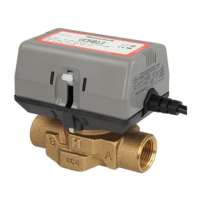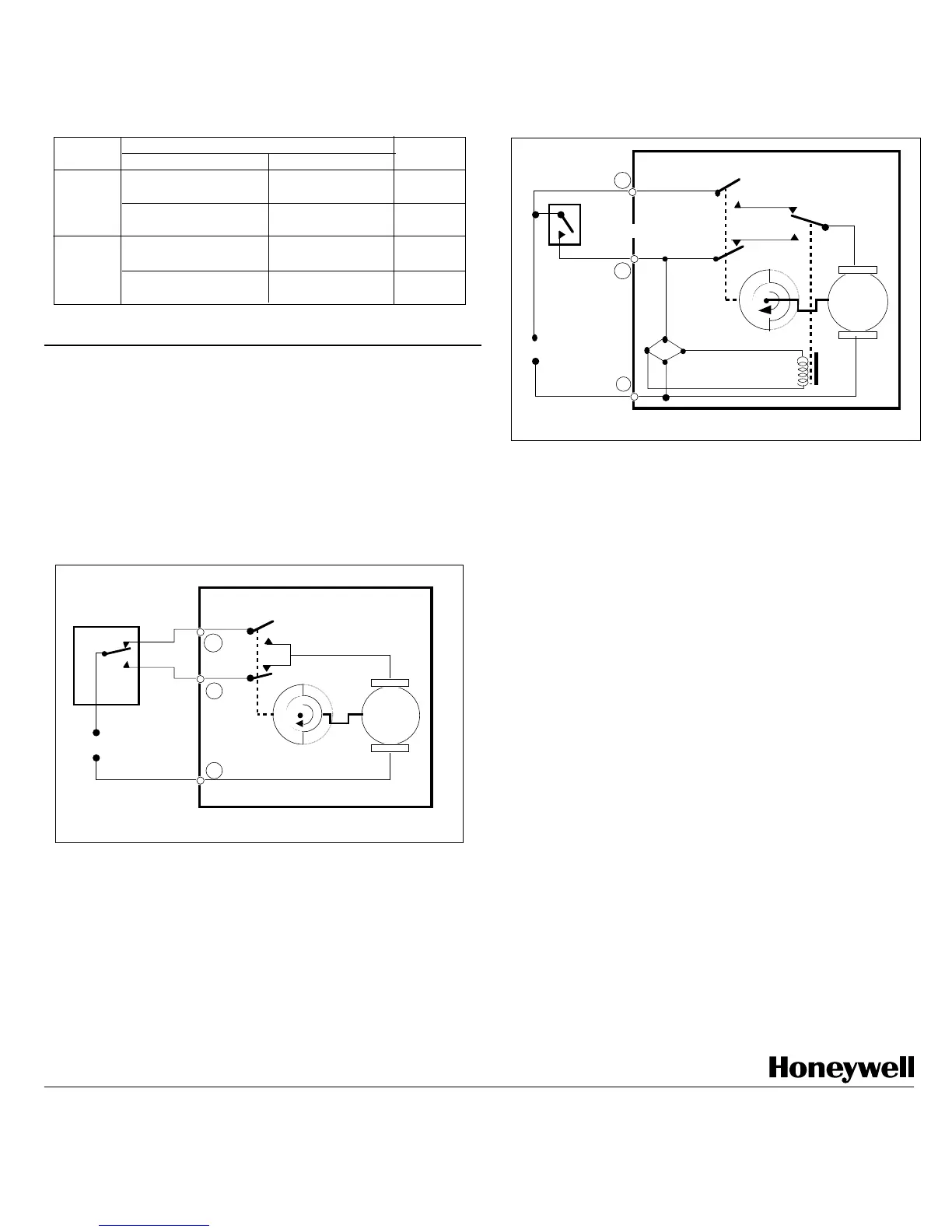Actuator
Connection
Va l v e
Movement Type Cable model Molex™ model
3-WIRE
(for SPDT
controller)
Blue & Brown energised
Black de-engergised
Pin# 2 & 3 energised
Pin# 6 de-energised
A port
closes
Blue & black energised
Brown de-energised
Pin# 2 & 6 energised
Pin# 3 de-energised
B port
closes
2 + COM.
(for SPST
controller)
Blue & Brown energised
Brown & Black open
Pin#2 & 3 energised
Pin# 3 & 6 open
A port
closes
Blue & Brown energised
Brown& Black closed
Pin# 2 & 3 energised
Pin# 3 & 6 closed
B port
closes
OPERATION
WHEN USED WITH SPDT (3-WIRE) CONTROLLER
(Fig. 6): On a call
for heat, the NO thermostat contacts close, the valve opens port "A" and
closes port "B". When the valve reaches port "A" fully open position, the
cam actuated SW1 closes and SW2 opens. When the need for heat is
satisfied, the NC thermostat contacts close, energising the valve through
SW1 to close port "A". When the port "A" is fully closed, the cam actuated
SW2 closes and SW1 opens anticipating the next call for heat cycle.
On power failure, the valve will stay at whatever position it was in when the
power was interrupted. When power is restored, the valve will respond to the
controller demand.
~
AC
MOTOR
CW
CAM
Valve
Close
Open
N
L
"VC "HYDRONIC VALVE
SW1
SW2
S.P.D.T.
CONTROLLER
NC
NO
BROWN
BLACK
BLUE
2
6
3
Figure 6: Actuator wiring for SPDT controller
WHEN USED WITH SPST CONTROLLER
(Fig. 7) : On a call for heat,
the thermostat contacts close. RLY1 is energized making the NO contacts
in SW3, valve opens port "A" and closes port "B". When the port "A" fully
open position is reached, the cam operated SW1 closes and SW2 opens.
When need for heat is satisfied, the thermostat contacts open. RLY1 is de-
energized making the NC contacts in SW3, and port "A" is driven close
through SW1 and the NC contacts of SW3. When the port "A" fully close
position is reached, the cam operated SW2 closes and SW1 opens
anticipating the next call for heat cycle.
Figure 6: Actuator wiring for SPST controller
~
"VC" HYDRONIC VALVE
AC
MOTOR
CW
CAM
RLY1
SW1
SW2
Valve
Close
Open
NC
NO
SW3
BLUE
BROWN
2
N
L
CONTROLLER
6
BLACK
3
S.P.S.T
.
CHECKOUT
1. Raise the set point of the thermostat above room temperature to
initiate a call for heat.
2. Observe all control devices - Port A should open, port B should
close and the auxiliary switch (if present) should operate and make
at the end of the opening stroke activating the auxiliary equipment.
3. Lower the set point of the thermostat below room temperature.
4. Observe the control devices. Port A should close and all auxiliary
equipment should stop.
SERVICE
This valve should be serviced by a trained, experienced service
technician.
1. If the valve is leaking , drain system OR isolate valve from the
system. Do not remove valve body from plumbing.
2. Check to see if the cartridge needs to be replaced.
3. If the motor or other internal parts of the actuator is damaged,
replace the entire actuator assembly.
NOTE: Honeywell hydronic valves are designed and tested for silent
operation in properly designed and installed systems. However, water
noises may occur as a result of excessive water velocity. Piping
noises may occur in high temperature (over 212°F [100°C]) systems
with insufficient water pressure.
Do not use boiler additives which are petroleum based or contain
mineral oil, hydrocarbons, or ethylene glycol acetate. Compounds
which can be used, with minimum 50% water dilution, are diethylene
glycol, ethylene glycol, and propylene glycol.
Automation and Control Solutions
In Canada:
Environmental Control Products
Honeywell Limited-Limitee
1985 douglas Drive North
35 Dynamic Drive
Golden Valley, MN 55422-3992
Toronto, ON M1V 4Z9
U.S.A.
Canada
Printed in Canada
By using this Honeywell literature, you agree that Honeywell will have no liability for any damages arising out of your use or modification to, the literature. You will defend and indemnify Honeywell, its affiliates and
subsidiaries, from and against any liability, cost, or damages, including attorneys’ fees, arising out of, or resulting from, any modification to the literature by you.

